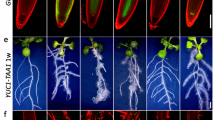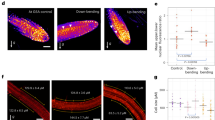Abstract
Re-orientation of Arabidopsis seedlings induces a rapid, asymmetric release of the growth regulator auxin from gravity-sensing columella cells at the root apex. The resulting lateral auxin gradient is hypothesized to drive differential cell expansion in elongation-zone tissues. We mapped those root tissues that function to transport or respond to auxin during a gravitropic response. Targeted expression of the auxin influx facilitator AUX1 demonstrated that root gravitropism requires auxin to be transported via the lateral root cap to all elongating epidermal cells. A three-dimensional model of the root elongation zone predicted that AUX1 causes the majority of auxin to accumulate in the epidermis. Selectively disrupting the auxin responsiveness of expanding epidermal cells by expressing a mutant form of the AUX/IAA17 protein, axr3-1, abolished root gravitropism. We conclude that gravitropic curvature in Arabidopsis roots is primarily driven by the differential expansion of epidermal cells in response to an influx-carrier-dependent auxin gradient.
This is a preview of subscription content, access via your institution
Access options
Subscribe to this journal
Receive 12 print issues and online access
$209.00 per year
only $17.42 per issue
Buy this article
- Purchase on Springer Link
- Instant access to full article PDF
Prices may be subject to local taxes which are calculated during checkout







Similar content being viewed by others
References
Muday, G. K. Auxin and tropisms. J. Plant Growth Regul. 20, 226–243 (2001).
Moore, I. Gravitropism: Lateral thinking in auxin transport. Curr. Biol. 12, 452–454 (2002).
Boonsirichai, K, Guan, C., Chen, R. & Masson, P. H. Root gravitropism: An experimental tool to investigate basic cellular and molecular processes underlying mechanosensing and signal transmission in plants. Annu. Rev. Plant Biol. 53, 421–447 (2002).
Blancaflor, E. B. & Masson, P. H. Plant gravitropism. Unravelling the ups and downs of a complex process. Plant Physiol. 133, 1677–1690 (2003).
Morita, M. T. & Tasaka, M. Gravity sensing and signalling. Curr. Opin. Plant Biol. 7, 712–718 (2004).
Sack, F. D. Plant gravity sensing. Intl. Rev. Cytol. 127, 193–252 (1991).
Blancfluor, E. B., Fasano, J. M. & Gilroy, S. Mapping the functional roles of cap cells in the response of Arabidopsis primary roots to gravity. Plant Physiol. 116, 213–222 (1998).
Weise, S. E., Kuznetsov, O. A., Hasenstein, K. H. & Kiss, J. Z. Curvature in Arabidopsis inflorescence stems is limited to the region of amyloplast displacement. Plant Cell Physiol. 41, 702–709 (2000).
Tanaka, A., Kobayashi, Y., Hase, Y. & Watanabe, H. Positional effect of cell inactivation on root gravitropism using heavy-ion microbeams. J. Exp. Bot. 53, 683–687 (2002).
Mullen, J. L., Ishikawa, H. & Evans, M. L. Analysis of changes in relative elemental growth rate patterns in the elongation zone of Arabidopsis roots upon gravistimulation. Planta 206, 598–603 (1991).
Bennett, M. J. et al. Arabidopsis AUX1 gene: A permease-like regulator of root gravitropism. Science 273, 948–950 (1996).
Chen, R. J. et al. The Arabidopsis thaliana AGRAVITROPIC 1 gene encodes a component of the polar-auxin-transport efflux carrier. Proc. Natl Acad. Sci. USA 95, 15112–15117 (1998).
Luschnig, C., Gaxiola, R., Grisafi, P. & Fink, G. EIR1, a root specific protein involved in auxin transport, is required for gravitropism in Arabidopsis thaliana. Genes Dev. 12, 2175–2187 (1998).
Muller, A. et al. AtPIN2 defines a locus of Arabidopsis for root gravitropism control. EMBO J. 17, 6903–6911 (1998).
Utsuno, K., Shikanai, T., Yamada, Y. & Hashimoto, T. AGR, an agravitropic locus of Arabidopsis thaliana, encodes a novel membrane-protein family member. Plant Cell Physiol. 39, 1111–1118 (1998).
Friml, J., Wisniewska, J., Benkova, E., Mendgen, K. & Palme, K. Lateral relocation of the auxin efflux regulator AtPIN3 mediates tropism in Arabidopsis. Nature 415, 806–809 (2002).
Rouse, D., Mackay, P., Stirnberg, P., Estelle, M. & Leyser, H. M. O. Changes in auxin response from mutations in an AUX/IAA gene. Science 279, 1371–1373 (1998).
Tian, Q. & Reed, J. W. Control of auxin regulated root development by the Arabidopsis thaliana SHY2/IAA3 gene. Development 126, 711–721 (1999).
Nagpal, P. et al. AXR2 encodes a member of the Aux/IAA protein family. Plant Physiol. 123, 563–574 (2000).
Leyser, H. M. O. et al. Arabidopsis auxin-resistance gene AXR1 encodes a protein related to ubiquitin activating enzyme E1. Nature 364, 161–164 (1993).
Fasano, J. M., Massa, G. D. & Gilroy, S. Ionic signalling in plant responses to gravity and touch. J. Plant Growth Regul. 21, 71–88 (2002).
Plieth, C. & Trewavas, A. J. Reorientation of seedlings in the Earth's gravitational field induces cytosolic calcium transients. Plant Physiol. 129, 786–796 (2002).
Monshausen, G. B. & Sievers, A. Basipetal propagation of gravity-induced surface pH changes along primary roots of Lepidium sativum L. Planta 215, 980–988 (2002).
Wolverton, C., Mullen, J. L., Ishikawa, H. & Evans, M. L. Root gravitropism in response to a signal originating outside of the cap. Planta 215, 153–157 (2002).
Aloni R., Langhans M., Aloni E. & Ullrich C. I. Role of cytokinin in the regulation of root gravitropism. Planta 220, 177–182 (2004).
Hu, X. Y., Neill, S. J., Tang, Z. C. & Cai, W. M. Nitric oxide mediates gravitropic bending in soybean roots. Plant Physiol. 137, 663–670 (2005).
Rashotte, A. M., DeLong, A. & Muday, G. K. Genetic and chemical reductions in protein phosphatase activity alter auxin transport, gravity response and lateral root growth. Plant Cell 13, 1683–1697 (2001).
Boonsirichai, K., Sedbrook, J. C., Chen, R., Gilroy, S. & Masson, P. H. ALTERED RESPONSE TO GRAVITY is a peripheral membrane protein that modulates gravity-induced cytoplasmic alkalinization and lateral auxin transport in plant statocytes. Plant Cell 15, 2612–2625 (2003).
Ottenslager, I. et al. Gravity-regulated differential auxin transport from columella to lateral root cap cells. Proc. Natl Acad. Sci. USA 100, 2987–2991 (2003).
Weijers, D., van Hamburg, J.-P., van Rijn, E., Hooykaas, P. J. J. & Offringa, R. Diphtheria toxin-mediated cell ablation reveals interregional communication during Arabidopsis seed development . Plant Physiol. 133, 1882–1892 (2003).
Swarup, R. et al. Localization of the auxin permease AUX1 suggests two functionally distinct hormone transport pathways operate in the Arabidopsis root apex. Genes Dev. 15, 2648–2653 (2001).
Blilou, I. et al. The PIN auxin efflux facilitator network controls growth and patterning in Arabidopsis roots. Nature 433, 39–44 (2005).
Tsurumi, S. & Ohwaki, Y. Transport of 14C-labeled indoleacetic acid in Vicia root segments. Plant Cell Physiol. 19, 1195–1206 (1978).
Friml, J., Benkova, E., Mayer, U., Palme, K. & Muster, G. Automated whole mount localisation techniques for plant seedlings. Plant J. 34, 115–124 (2003).
Kramer, E. M. PIN and AUX/LAX proteins: their role in auxin accumulation. Trends Plant Sci. 9, 578–582 (2004).
Beemster, G. & Baskins, T. Stunted Plant1 mediates effects of cytokinin, not auxin, on cell division and expansion in the root of Arabidopsis. Plant Physiol. 124, 1718–1727 (2001).
Knox, K., Grierson, C. S. & Leyser, H. M. O. AXR3 and SHY2 interact to regulate root hair development. Development 130, 5769–5777 (2003).
Tiwari, S. B., Hagen, G. & Guilfoyle, T. The role of auxin response factor domains in auxin-responsive transcription. Plant Cell 15, 533–543 (2003).
Li, H., Johnson, P., Stepanova, A., Alonso, J. M. & Ecker, J. R. Convergence of signalling pathways in the control of differential cell growth in Arabidopsis. Dev. Cell 7, 193–204 (2004).
Harper, R. M. et al. The NPH4 locus encodes the auxin response factor ARF7, a conditional regulator of differential growth in aerial Arabidopsis tissues. Plant Cell 12, 757–770 (2000).
Hardtke, C. S. & Berleth, T. The Arabidopsis gene MONOPTEROS encodes a transcription factor mediating embryo axis formation and vascular development. EMBO J. 17, 1405–1411 (1998).
Konings, H. On the mechanism of tranverse distribution of auxin in geotropically exposed pea roots. Acta Bot. Neerl. 16, 161–176 (1967).
Ohwaki, Y. & Tsurumi, S. Auxin transport and growth in intact roots of Vicia faba. Plant Cell Physiol. 17, 1329–1342 (1976).
Yamamoto, M. & Yamamoto, K. Differential effects of 1-naphthalenic acid, indole-3-acetic acid and 2,4-dichlorophenoxyacetic acid on the gravitropic response of roots in an auxin resistant mutant of Arabidopsis, aux1. Plant Cell Physiol. 39, 660–664 (1998).
Marchant, A. et al. AUX1 regulates root gravitropism in Arabidopsis by facilitating auxin uptake. EMBO J. 18, 2066–2073 (1999).
Peters, W. S. & Tomos, A. D. The mechanic state of “inner tissue” in the growing zone of sunflower hypocotyls and the regulation of its growth rate following excision. Plant Physiol. 123, 605–612 (2000).
Kutschera, U. Tissue stresses in growing plant organs. Phys. Plant. 77, 157–163 (1989).
Swarup, R. et al. Structure-function analysis of the presumptive Arabidopsis auxin permease AUX1. Plant Cell 16, 3069–3083 (2004).
van der Weele, C. M. et al. A new algorithm for computational image analysis of deformable motion at high spatial and temporal resolution applied to root growth. Roughly uniform elongation in the meristem and also, after an abrupt acceleration, in the elongation zone. Plant Physiol. 132, 1138–1148 (2003).
Acknowledgements
We would like to thank the Nottingham Arabidopsis Stock Centre (NASC) for providing selected GAL4 enhancer trap lines used in this study and D. Weijers for the GAL4-related constructs. We also thank M. Broadley, J. Friml, D. Grierson, C. Hodgman, M. Holdsworth, L. Laplaze, J. Roberts, P.J. White, Z. Wilson and anonymous referees for helpful comments about the manuscript. The work was supported by the Biotechnology and Biological Sciences Research Council (R.S., P.P., K.K., H.M.O.L. and M.J.B.); European Space Agency (R.S. and M.J.B.); EU Training site grant HTMC-CT-2000-00088 awarded to P.P.; Gatsby Charitable Foundation (J.H. and M.J.B.); Formas and V.R. (R.B.).
Author information
Authors and Affiliations
Corresponding author
Ethics declarations
Competing interests
The authors declare no competing financial interests.
Supplementary information
Supplementary Information
Supplementary text providing additional details of the computer model and References plus Supplementary tables S1, S2, S3 and S4 plus Supplementary figures S1, S2, S3, S4 and S5 (PDF 375 kb)
Rights and permissions
About this article
Cite this article
Swarup, R., Kramer, E., Perry, P. et al. Root gravitropism requires lateral root cap and epidermal cells for transport and response to a mobile auxin signal. Nat Cell Biol 7, 1057–1065 (2005). https://doi.org/10.1038/ncb1316
Received:
Accepted:
Published:
Issue Date:
DOI: https://doi.org/10.1038/ncb1316
This article is cited by
-
A root cap-localized NAC transcription factor controls root halotropic response to salt stress in Arabidopsis
Nature Communications (2024)
-
Research advances in plant root geotropism
Plant Growth Regulation (2024)
-
Multiscale Asymptotic Analysis Reveals How Cell Growth and Subcellular Compartments Affect Tissue-Scale Hormone Transport
Bulletin of Mathematical Biology (2023)
-
Arabidopsis PLDζ1 and PLDζ2 localize to post-Golgi membrane compartments in a partially overlapping manner
Plant Molecular Biology (2022)
-
Cellular and ultrastructural alterations of Arabidopsis thaliana roots in response to exogenous trans-aconitic acid
Acta Physiologiae Plantarum (2022)



